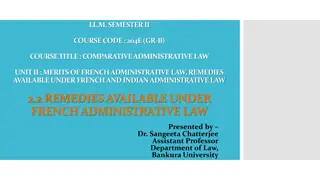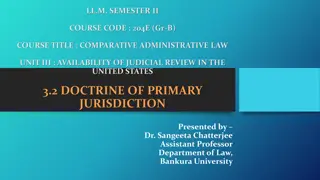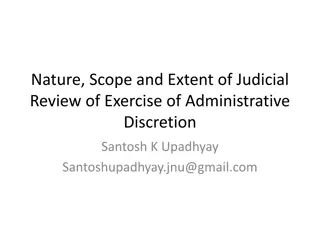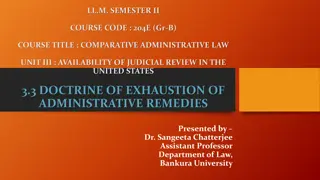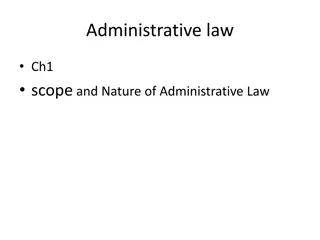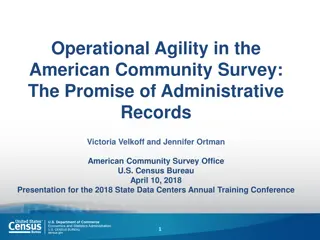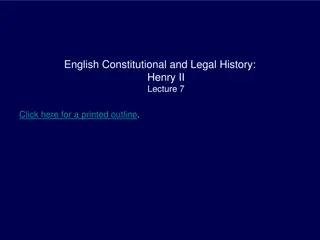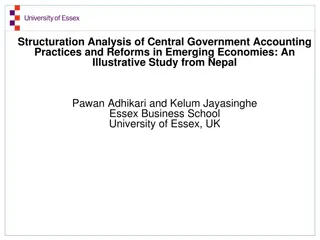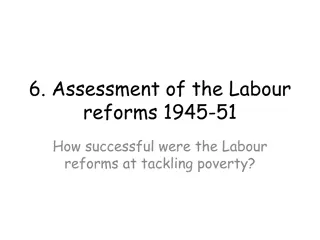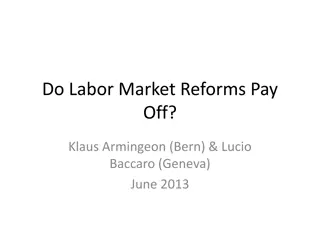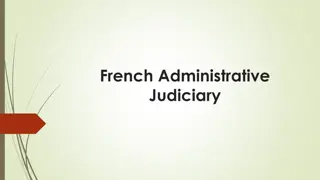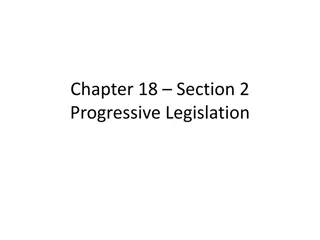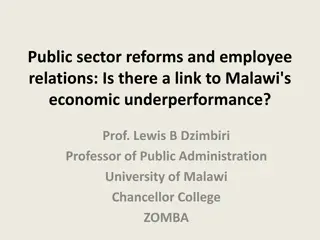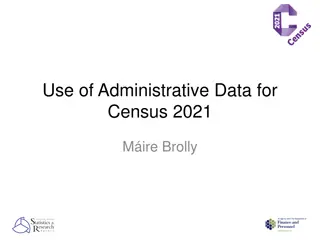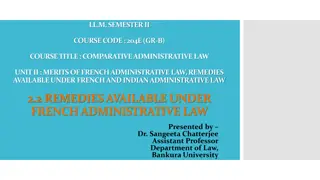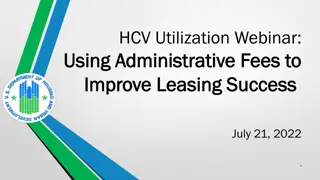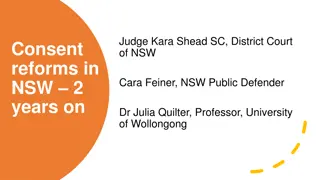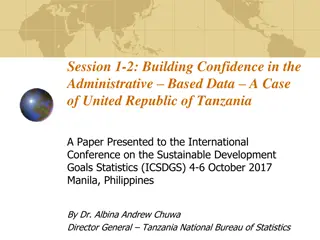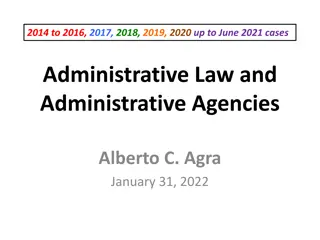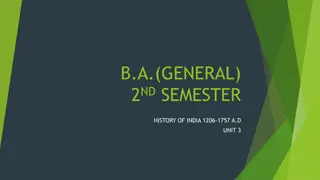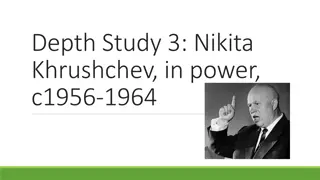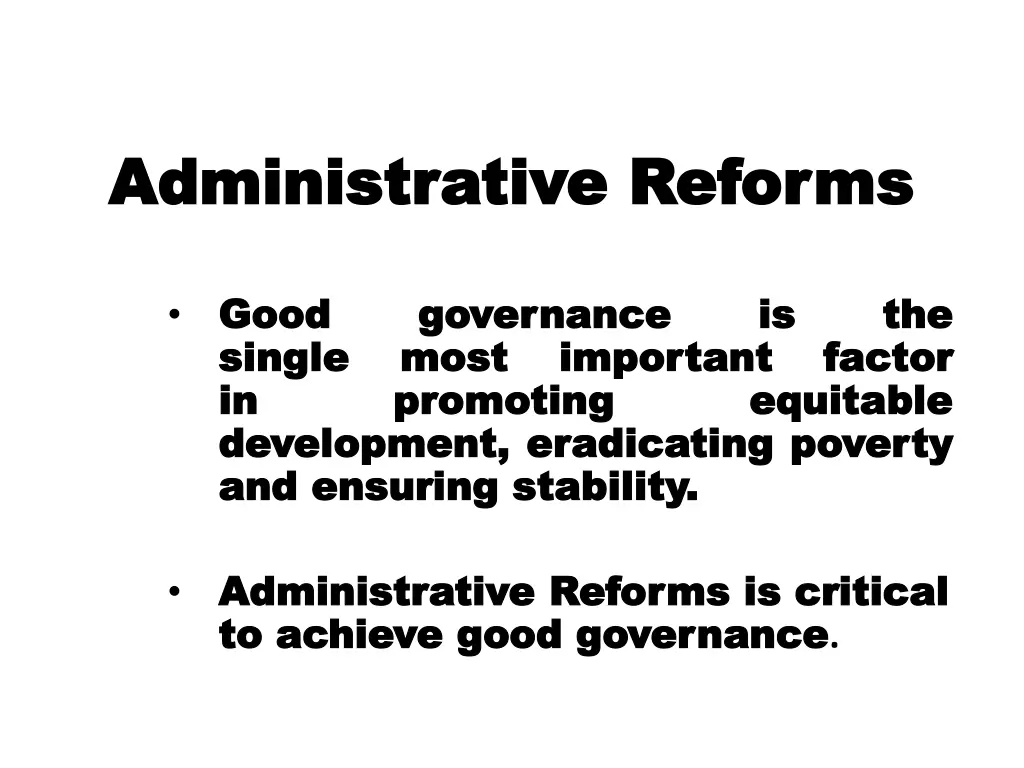
Role of Administrative Reforms in Good Governance
Explore the significance of administrative reforms in promoting good governance, eradicating poverty, and ensuring stability. Learn about the definition of administrative reforms, major commissions, and developments necessitating reforms. Delve into the challenges faced and subjects to be addressed for effective administration at various levels.
Download Presentation

Please find below an Image/Link to download the presentation.
The content on the website is provided AS IS for your information and personal use only. It may not be sold, licensed, or shared on other websites without obtaining consent from the author. If you encounter any issues during the download, it is possible that the publisher has removed the file from their server.
You are allowed to download the files provided on this website for personal or commercial use, subject to the condition that they are used lawfully. All files are the property of their respective owners.
The content on the website is provided AS IS for your information and personal use only. It may not be sold, licensed, or shared on other websites without obtaining consent from the author.
E N D
Presentation Transcript
Administrative Reforms Administrative Reforms Good Good single single in in development, development, eradicating and and ensuring ensuring stability governance governance most most promoting promoting eradicating poverty stability. . is is the the important important factor factor equitable equitable poverty Administrative Reforms is critical Administrative Reforms is critical to achieve good governance to achieve good governance.
Definition of Administrative Reforms Definition of Administrative Reforms Consciously induced and directed changes in the machinery of government both in its institutions and processes at all levels . It involves structural changes (rather than merely incremental or marginal adjustments). Ideally Administrative Reforms should be an ongoing process since it needs to be in step with the requirements and needs of the time. 2
Two Commissions (1966 and 2005). major Administrative Reforms In appointed in 1968. Maharashtra Hebale Committee More recently The Madhav Godbole One Man Committee on Good Governance . 3
2nd Commission Administrative Reforms This This was recent recent developments developments necessitated the the need need to to look look at reforms reforms in in a a comprehensive comprehensive and holistic holistic manner manner. . was set set up up in in 2005 2005 because necessitated at administrative administrative because and 4
Major developments necessitating administrative reforms Globalization Increasing disparities all regions have not progressed uniformly Deregulation and privatization Increased awareness about rights State no longer main source of information Emergence of powerful technological solutions - IT The State now called upon to be a facilitator, promoter and partner; formerly interventionist, producer and seller. Participative not merely representative democracy with the citizens at the centre of programmes/policies as clients not beneficiaries. 5
The ARC was asked to consider the following subjects (i) (ii) (iii) (iv) (v) (vi) (vii) Local Self-Government/Panchayati Raj Institutions (viii) Social Capital, Trust and Participative public service delivery (ix) Citizen-centric administration (x) Promoting e-governance (xi) Issues of Federal Policy (xii) Crisis Management (xiii) Public Order Organisational structure of the Government of India Ethics in governance Refurbishing of Personnel Administration Strengthening of Financial Management Systems Steps to ensure effective administration at the State level Steps to ensure effective District Administration 6
The Commission identified five broad areas where Governance needs to be strengthened: ( (i i) ) Public Public order, of of law law order, justice justice and and rule rule The ARC s reports on Maintenance of Public Order, Combating Terrorism, Conflict Resolution and Ethics in governance have made a number of recommendations in these areas which need urgent implementation. 7
The Commission identified five broad areas where Governance needs to be strengthened: (ii)Human development through access to education and healthcare good quality Recommendations of the ARC in respect of the above are contained in its Reports on Citizen Centric Administration, Social Capital and Trusts and promoting E-governance. 8
The Commission identified five broad areas where Governance needs to be strengthened: (iii)Infrastructure and sustainable natural resource development Recommendations of the ARC are contained in its Report on Local Self- Governance. 9
The Commission identified five broad areas where Governance needs to be strengthened: (iv)Social Security As an illustrative example, we have examined how NREGA can be streamlined and enhanced for better capital formation. We have e.g. suggested that skills development can be dovetailed as a part of this important programme. 10
The Commission identified five broad areas where Governance needs to be strengthened: (v)Third Tier of Governance Local Self Institutions both urban Governance rural and Report Report on on Local Local Self Self Governance Governance 11
Challenges Challenges Serious resource constraints Laws alone cannot address fundamental fiscal problems. Revenue cannot be increased by enhancing tax rates in a centralized administration. Need to raise resources, reduce unproductive subsidies and get better outcome for every rupee utilized. Administration must become far more accountable and effective in delivering results with the same expenditure. Outcome overlooked. In order to accomplish these goals, conscious efforts to establish link between the citizen s vote and public good and taxes and services. Fuse authority with accountability at every level. 12
Challenges Challenges Pervasive corruption Pervasive corruption Pervasive Pervasive corruption corruption is governance governance. . It It has has been include include: : The The colonial colonial legacy legacy of arbitrarily arbitrarily. . The The enormous enormous asymmetry asymmetry of A A set set of of policies policies whose mercy mercy of of the the State State. . Over excessive excessive state state control, control, near an an economy economy of of scarcity corruption corruption. . is the the most been aggravated aggravated by most disturbing disturbing element by various various factors, element of factors, which of our which our of unchallenged unchallenged authority authority and and propensity propensity to to exercise exercise power power of powers powers in unintended consequence consequence was Over regulation, regulation, severe near- -monopoly monopoly of scarcity all all facilitated facilitated conditions in our our society society. . whose unintended to put put the on economic economic activity, government in in many many sectors conditions conducive conducive to was to the citizen citizen at at the the activity, sectors and to unbridled unbridled severe restrictions restrictions on of the the government and Asymmetry of Asymmetry of power power 13
Challenges Challenges Past Past valuable valuable lessons corruption corruption Monopoly Monopoly and and corruption corruption while while competition corruption corruption. . Wherever Wherever transparency transparency and corruption corruption has has been been significantly Core Core principles principles of of good corruption corruption. . Need Need to to strengthen strengthen anti legislations, legislations, e e. .g g. . the Act Act. . lessons in in curbing curbing discretion discretion competition and increase increase and transparency transparency reduce the the propensity propensity to to reduce and technology technology has significantly contained good governance governance are has been been introduced, introduced, contained. . are necessary necessary to to combat combat anti- -corruption corruption laws the False False Claims Claims Act laws and Act on on the and enact enact new the lines lines of of the new US the US 14
Common underlying theme of Reports: Rule of law which requires that laws and their implementation predictable, equitable and credible. Accountability at administration. Minimization of unfettered discretion. Putting the citizen first. Principle of subsidiarity (which implies both devolution authority). be transparent, each level of and delegation of 15
Focus for todays discussion Key components of Civil Services Reforms Civil Services Reforms have to be an important element of any programme for good governance Madhav Godbole Organizational Government of India structure of 16
Civil Introduction Services Reforms- There is a perception that civil services and administration have become wooden, inflexible and self-perpetuating, creating a barrier between Government and Society. 17
Civil Introduction Services Reforms- Some Some reasons reasons are are: : Systemic rigidities; Needless centralization with authority divorced from accountability. complexities and over- 18
Civil Introduction: Services Reforms - The contribution of the civil services in our socio-economic and political development is well acknowledged. competent allocation management and the way administration responds to major natural calamities indicates that we have an administrative responds well when: Objectives are clearly defined; Resources are made available; and Accountability is enforced. Even today infrastructure which 19
Civil Introduction Services Reforms- Some Some Services Services Reforms core core Reforms: : principles principles of of Civil Civil Professionalization tenure and competition; Citizen Centric Administration; Accountability; Emphasis on outcome orientation; and Promoting service values and ethics. with stability of 20
Civil Introduction Based Based on of of reforms reforms has cover cover the the following Services Reforms- on these these core has been following broad core principles, principles, a a set been suggested suggested to broad areas areas: : set to Recruitment and capacity building Placement and transfer policy Performance Accountability (horizontal delegation at every level) Ethical Code for Civil Servants. Management and 21
Civil Services Reforms New Examination system: Major reforms have been suggested in the existing system of Civil Services examination so that the concept of evaluating aspiring civil servants on a set of specific core subjects like Constitution of India, Indian Legal System, Economy, Polity, Culture etc. will become institutionalized and replace the existing system, which had allowed proliferation on a large variety of unrelated and often asoteric subjects not relevant for Public Services and not comparable purposes. for evaluation 22
Civil Services Reforms Capacity Building All civil servants should undergo mandatory training before each promotion and each officer/official should be evaluated after each training programme. Successful completion of the training programmes should be made mandatory for promotions. The objective of mid-career training should be to develop domain knowledge and competence required for the changing job profile of the officer. Need for a strong network of training institutes at the State level. 23
Promoting Professionalism and Competition Civil Services Authority The phrase right person for the right job has become a clich but it is the sine qua non for good governance. This would require reforms and institutionalization of a number of processes which are transparent and free from extraneous considerations. 24
Promoting Professionalism and Competition Civil Services Authority To facilitate this, a 5 member Civil Services Authority should be constituted under the proposed Civil Services Bill. The Chairperson and members should be persons of eminence in public life to be appointed on the recommendations of a committee consisting of the Prime Minister and the Leader of Opposition. The Authority should perform the following tasks: Assignment of domains to officers Preparing panels for posting of officers at the level of Joint Secretary and above. Fixing tenure of posts Deciding on issues pertaining to lateral entry. 25
Domain Competency Right person for the right job Domain competency relates to sufficient background in a certain context of policy making. It differs from general schemes of policy programme formulation in that such general skills would relate primarily to knowledge of formal techniques of policy analysis/programme formulation and experience of policy/programme formulation generally, while DomainCompetence would involve, in addition, significant subject matter knowledge, gained from work experience, academic study, training and research. 26
Domains Domains The 2nd ARC has suggested following 12 domains: General Administration Urban development Security Rural Development Financial Management Infrastructure HRD Social Empowerment Economic Administration Tax Administration Agriculture Development Natural Resources Administration Health Management 27
Assignment of Domains Domains should be assigned on completion of 13 years of service. The applications academic background and other reasons relevant to the Domain applied for. Civil Services from Authority officers should specifying invite their The Civil Services Authority through a consultative process should assign Domain on the basis of this exercise. 28
Placement at top management level There is need to introduce competition for senior positions in government (SAG and above) by opening these positions in Government (including attached and subordinate offices) to all Services. This principle would apply to all posts including those that are presently encadred with the organised Group A Services. Note Based on the concept of a Senior Executive Service in countries like UK, Australia etc. 29
Placement at top management level The applications from amongst eligible officers for positions for HAG level and above, would conduct interviews and shortlist suitable officers for these posts. Government would make final selection. Civil Services Authority would invite The Civil Services Authority in consultation with Government would earmark position for jobs for which outside talent Applications to fill up these posts should be invited from interested and eligible persons from the open market and also serving eligible officers. would be desirable. 30
Accountability Although mechanisms to promote accountability, these are not adequate/effective in ensuring the same. there are external and internal Various reasons have been attributed for this: Lifelong job security provided to government servants leading to a distorted incentive structure where rarely is a government servant punished or removed for poor performance, for acts of omission etc. This has manifested itself often in terms of indifference and disregard of citizens concerns. 31
Accountability Table 13.1 : Institutions and Mechanisms that Promote Accountability Outside the State (Vertical) To the people through elections Through RTI Act to citizens High effectiveness Citizens oversight committees Civil society/watchdog bodies Media Low effectiveness Service delivery surveys Citizens charter Low to medium effectiveness Within the State (Horizontal) External (Outside the Executive) Internal (Within the Executive) Parliament Judiciary Lokayukta CAG CVC Superior officers 1. Rewards/Punishment 2. Disciplinary procedures 3. Performance Management System CBI/police/vigilance Internal Audit Grievance Redressal Mechanisms 32
Accountabilitymeasures recommended A system of two reviews one on completion of 14 years and another on completion of 20 years. The second review should assess the fitness of the officer for further continuance in government service. 33
Simplifying Disciplinary Proceedings Today, there are over 30 stages involved in disciplinary proceedings from preliminary evidence to consultation with CVC and UPSC. The ARC has suggested simplifying the procedure without compromising with the principles of natural justice. It has, for example, suggested that the two state consultation with the CVC should be done away and advice sought only once after completion of disciplinary process. Consultations with the UPSC would be mandatory only where dismissal of a government servant is proposed. Oral inquiry process be converted into disciplinary meeting or interview with the superior officer in summary manner. Present CCS (CCA) Rules be repealed and substituted with appropriate Regulations. 34
Performance Appraisal System Performance Appraisal System Change in the Performance Appraisal System is a pre-requisite to ensure fairness in various Civil Services reforms. 35
Performance Appraisal System Performance Appraisal System Weaknesses in the present system It does not recognize the difference in performance parameters applicable to civil services working in completely different departments; There is element of subjectivity when it comes to assigning numeric rate grades; It emphasizes the performance appraisal report as the key element; It does not adequately size the potential of an officer; There are too many levels for ratings; and It emphasizes career development but does not link it sufficiently with performance improvements 36
Performance Appraisal System Reforms Suggested Performance Appraisal Forms to be made more job specific with three sections: A generic section that meets the requirements of a particular service to which the officer belongs Another section based on the goals and requirements of the department in which he/she is working; and A final section which captures the specific requirements and targets relating to the post that the officer is holding. 37
Performance Management System Performance Management System Linking individual contributions to strategic objectives of the organization Annual performance agreements between departmental Ministers and Secretaries for providing verifiable details of work to be done based on the following principles: What gets measured gets done. If you don t measure results, you can t tell success from failure. If you can t see success, you can t reward it. If you can t reward success you are probably rewarding failure. If you can t recognize failure, you can t correct it. If you can t demonstrate results, you can t win public support. 38
Performance Appraisal System Reforms Suggested Performance Appraisal Forms to be made more job specific with three sections: A generic section that meets the requirements of a particular service to which the officer belongs Another section based on the goals and requirements of the department in which he/she is working; and A final section which captures the specific requirements and targets relating to the post that the officer is holding. 39
Punitive Transfers Frequent transfers are often a result of punitive measures, which adversely affect governance and is demoralizing. Study on IAS based tenures between 1978 and 2006 indicated that between 55% to 60% of officers did less than one year in their job. To combat this, Hota Committee has recommended establishment of Civil Services Boards at the Centre and the States under a statute, with responsibility to fix tenure of civil service posts. In case of transfer before tenure, a system laid down to deal with it. 40
Punitive Transfers ARC recommended that in the code of ethics for Ministers the following should be included: Ministers must uphold the political impartiality of the civil service and not ask the civil servants to act in any way which would conflict with the duties and responsibilities of the civil servants ARC has recommended changes in the Prevention of Corruption Act to include obstruction or perversion of justice by unduly influencing law enforcement agencies and gross-perversion of the Constitution, including willful violation of oath of office. 41
Civil Services Code Civil Services Code ARC comprehensive civil code at three levels had conceptualized a At apex level, there should be a clear and concise statement of values which should reflect public expectations from a civil servant with reference impartiality, maintenance of the highest ethical standards and accountability for actions. to political 42
Civil Services Code Civil Services Code At second level will be the broad principles which should govern the behaviour of the civil servant. 43
Civil Services Code Civil Services Code Third level would be a specific code of conduct stipulating in a precise and unambiguous manner, a list of acceptable and unacceptable behaviour with actions. 44
Civil Services Law Civil Services Law A new Civil Services Law needs to be enacted which would incorporate civil service values, recruitment and conditions of service, fixation of tenures, dismissal, removal, etc. of civil servants, creations of executive agencies etc. code of ethics, 45
Organizational Structure of Organizational Structure of Government of India Government of India Strengths Time Tested System adherence to rules and established norms. Provided stability during transfer of power through elections. Commitment to the Constitution political neutrality. Link between policy making and its implementation. A national outlook amongst the public functionaries. 46
Organizational Structure of Organizational Structure of Government of India Government of India Weaknesses Undue emphasis on routine functions. Proliferation of Ministries/Departments weak integration and coordination. An extended hierarchy with too many levels. Risk avoidance. Absence of team work. 47
Changes Changes in the the Government Government in organizational organizational structure structure of of The principle of subsidiarity should be followed to decentralize functions to State and Local Governments. 48
Changes Changes in the the Government Government in organizational organizational structure structure of of Subjects which are closely inter-related should be dealt with together. 49
Changes Changes in the the Government Government in organizational organizational structure structure of of Separation of policy making functions from execution and Formation Agencies. of Executive 50


